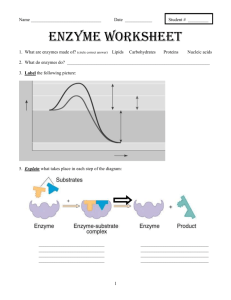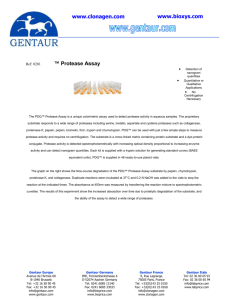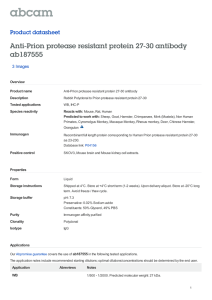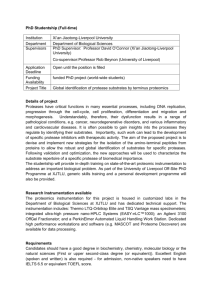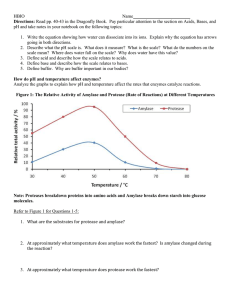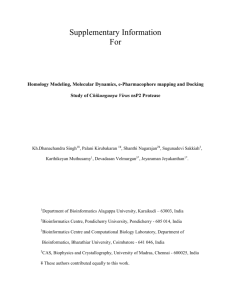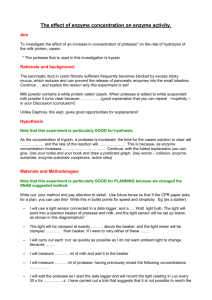Neutralization of Burkholderia pseudomallei Protease by Fabs Generated through Phage Display ,
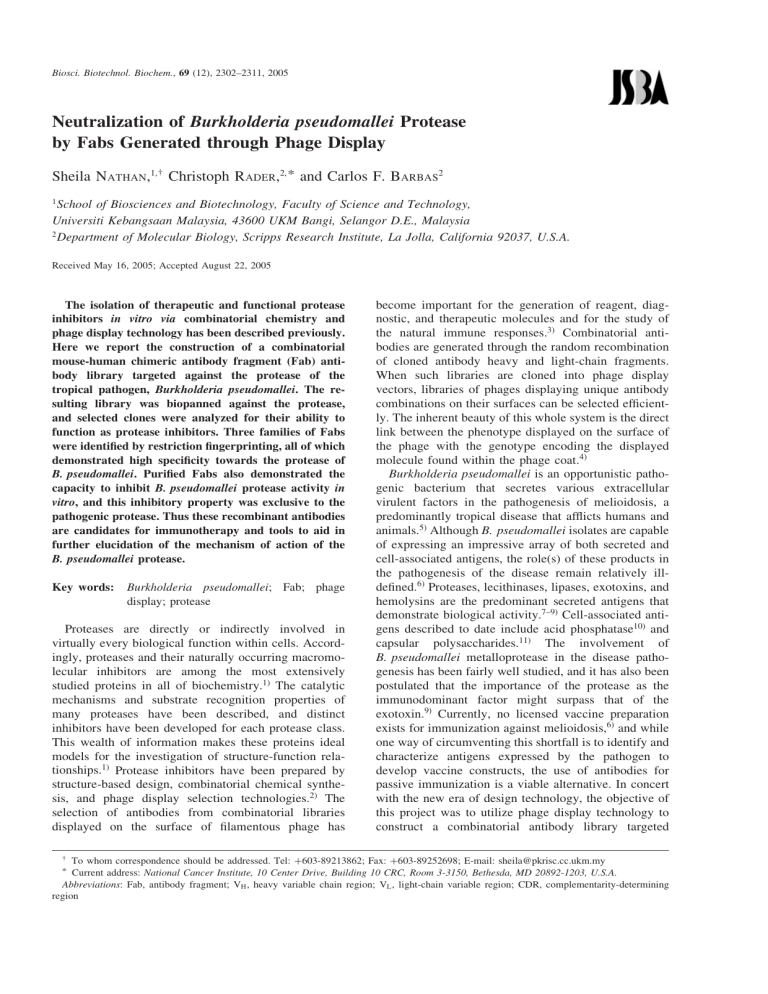
Biosci. Biotechnol. Biochem.
, 69 (12), 2302–2311, 2005
Neutralization of Burkholderia pseudomallei Protease by Fabs Generated through Phage Display
Sheila N
ATHAN
,
1 ; y
Christoph R
ADER
,
2 ; *
and Carlos F. B
ARBAS
2
1 School of Biosciences and Biotechnology, Faculty of Science and Technology,
Universiti Kebangsaan Malaysia, 43600 UKM Bangi, Selangor D.E., Malaysia
2 Department of Molecular Biology, Scripps Research Institute, La Jolla, California 92037, U.S.A.
Received May 16, 2005; Accepted August 22, 2005
The isolation of therapeutic and functional protease inhibitors in vitro via combinatorial chemistry and phage display technology has been described previously.
Here we report the construction of a combinatorial mouse-human chimeric antibody fragment (Fab) antibody library targeted against the protease of the tropical pathogen, Burkholderia pseudomallei . The resulting library was biopanned against the protease, and selected clones were analyzed for their ability to function as protease inhibitors. Three families of Fabs were identified by restriction fingerprinting, all of which demonstrated high specificity towards the protease of
B. pseudomallei . Purified Fabs also demonstrated the capacity to inhibit B. pseudomallei protease activity in vitro , and this inhibitory property was exclusive to the pathogenic protease. Thus these recombinant antibodies are candidates for immunotherapy and tools to aid in further elucidation of the mechanism of action of the
B. pseudomallei protease.
Key words: Burkholderia pseudomallei display; protease
; Fab; phage
Proteases are directly or indirectly involved in virtually every biological function within cells. Accordingly, proteases and their naturally occurring macromolecular inhibitors are among the most extensively studied proteins in all of biochemistry.
1) The catalytic mechanisms and substrate recognition properties of many proteases have been described, and distinct inhibitors have been developed for each protease class.
This wealth of information makes these proteins ideal models for the investigation of structure-function relationships.
1) Protease inhibitors have been prepared by structure-based design, combinatorial chemical synthesis, and phage display selection technologies.
2) The selection of antibodies from combinatorial libraries displayed on the surface of filamentous phage has become important for the generation of reagent, diagnostic, and therapeutic molecules and for the study of the natural immune responses.
3) Combinatorial antibodies are generated through the random recombination of cloned antibody heavy and light-chain fragments.
When such libraries are cloned into phage display vectors, libraries of phages displaying unique antibody combinations on their surfaces can be selected efficiently. The inherent beauty of this whole system is the direct link between the phenotype displayed on the surface of the phage with the genotype encoding the displayed molecule found within the phage coat.
4)
Burkholderia pseudomallei is an opportunistic pathogenic bacterium that secretes various extracellular virulent factors in the pathogenesis of melioidosis, a predominantly tropical disease that afflicts humans and animals.
5) Although B. pseudomallei isolates are capable of expressing an impressive array of both secreted and cell-associated antigens, the role(s) of these products in the pathogenesis of the disease remain relatively illdefined.
6) Proteases, lecithinases, lipases, exotoxins, and hemolysins are the predominant secreted antigens that demonstrate biological activity.
7–9)
Cell-associated antigens described to date include acid phosphatase
10) capsular polysaccharides.
11)
The involvement and of
B. pseudomallei metalloprotease in the disease pathogenesis has been fairly well studied, and it has also been postulated that the importance of the protease as the immunodominant factor might surpass that of the exotoxin.
9) Currently, no licensed vaccine preparation exists for immunization against melioidosis, 6) and while one way of circumventing this shortfall is to identify and characterize antigens expressed by the pathogen to develop vaccine constructs, the use of antibodies for passive immunization is a viable alternative. In concert with the new era of design technology, the objective of this project was to utilize phage display technology to construct a combinatorial antibody library targeted y
*
To whom correspondence should be addressed. Tel: +603-89213862; Fax: +603-89252698; E-mail: sheila@pkrisc.cc.ukm.my
Current address: National Cancer Institute, 10 Center Drive, Building 10 CRC, Room 3-3150, Bethesda, MD 20892-1203, U.S.A.
Abbreviations : Fab, antibody fragment; V
H
, heavy variable chain region; V
L
, light-chain variable region; CDR, complementarity-determining region
Materials and Methods
Immunization of animals with B. pseudomallei protease.
Protease was purified from 7-d stationary cultures of a human clinical isolate of B. pseudomallei by ammonium sulfate precipitation followed by DEAE
Cellulose and CM-Sepharose column chromatography, as previously described.
11)
The purified protease was subsequently used for the immunization of four Balb/C mice (henceforth referred to as #1, #2, #3, and #4) according to standard immunization procedures.
12)
20 C until required.
The animals were given three boosts of the antigen and at appropriate times were bled, and sera samples were analyzed by indirect Enzyme-linked Immunosorbent
Assay (ELISA) to determine titers. A 96-well plate
(COSTAR, U.S.A.) was coated with 100 ng protease (in
0.1
M sodium bicarbonate (NaHCO
3
) buffer, pH 9.6) or with 1% BSA overnight at 4 C. The following day the wells were washed with distilled water and blocked with
5% milk powder (150 m l) for 1 h at 37 C. Diluted sera
(1:100) were added to the appropriate wells and incubated at 37 C for 2 h. Following extensive washing, alkaline phosphatase-conjugated goat anti-mouse IgG
(1:1000, Pierce, U.S.A.) was added for 1 h at 37 C. 2-2 0 -
Azino-Bis-(3-ethylbenzthiazoline sulphonic acid)-hydogen peroxide (ABTS–H
2
O
2
) substrate was subsequently added, and color development was monitored at 405 nm.
Following the demonstration of sufficient antibody titer, the animals were given a final boost with the antigen, and 5 d later, the spleens were harvested and the mice were exsanguinated. Sera were obtained from the blood and stored at
Neutralization of Burkholderia pseudomallei Protease against the protease of B. pseudomallei . These antibodies might potentially serve as anti-protease molecules as well as concomitantly contributing to understanding of the structure-function relationships between the proteases. This paper reports on the construction and analysis of the recombinant mouse-human Fab clones and their specificity towards the B. pseudomallei metalloprotease. Chimeric Fabs with human constant regions can easily be detected with anti-human Fab reagents, and they are usually better expressed in the bacterial host than are mouse antibody fragments.
4) Mousehuman chimeric Fabs towards the B. pseudomallei protease can also readily be channeled into the humanization of clones with therapeutic potential.
Chimeric human-mouse Fab library construction.
Total RNA was prepared from harvested mice spleen using TRI Reagent (MRC, Cincinnati, OH) according to the manufacturer’s instructions. Briefly, spleens were homogenized and extracted RNA was precipitated with
RNase-free isopropanol and dissolved in nuclease-free water. If necessary, the total RNA was further purified with lithium chloride (2
M
), followed by precipitation with ethanol (100%) and sodium acetate (3
M
) to improve the quality of the RNA. mRNA was reverse-
2303 transcribed with the SUPERSCRIPT Preamplification
System for First Strand cDNA Synthesis Kit (Life
Technologies, NJ) according to the manufacturer’s protocol. Typically, 20 fied using mixes of 17 m g total RNA was utilized as template for priming by oligo-dT primers. Resulting first-strand cDNAs from each mouse were PCR amplisense primers (V were used for amplification of the V
H
-specific) and
4 antisense primers (J -specific) for PCR amplification of the V region. Only one sense and one antisense primer were used for amplification of the V regions.
4)
Nineteen sense primers and three anti-sense primers regions. The kappa and lambda products were pooled, as were heavychain products, and purified using the Qiagen PCR
Purification System or gel purified (Qiagen Gel Extraction System, Germany). The antisense primers consist of a hybrid mouse/human sequence designed for fusion of mouse V
L and V
H coding sequences to human C and
C
H
1 coding sequences respectively. Human C and C
H
1 coding sequences were amplified from a pComb3Hcompatible expression vector
3) that contained the sequence of a human Fab directed to tetanus toxoid
13) using the primer combinations HKC-F (5-actgtggctgcaccatctgtc-3 0 )/lead-B (5 0 gccatggctggttgggcagc-3 0 ) and
HIgGCH1-F (5 0 -gcctccaccaagggcccatcggtc-3 0 )/dpseq
(5 0 -agaagcgtagtccggaacgtc-3 0 ) respectively. The antisense primer lead-B hybridizes to a sequence upstream of the Fd fragment coding sequence and is used to amplify the C coding sequence together with the sequence intervening light- and heavy-chain fragment coding sequences in phagemid vector pComb3H.
14)
Based on this strategy, the chimeric mouse/human light- and heavy-chain fragment coding sequences were assembled and fused by two sequential overlap extension PCR steps. In the first step, mouse V
L and human
C were fused using the primer combination RSC-F
(5
0
-gaggaggaggaggaggaggcggggcccaggcggccgagctc-3
0
)/ lead-B, and mouse V
H and human C
H
1 were fused using the primer combination lead-V
H catggcc-3 0 ) and dp-EX (5 0
(5-gctgcccaaccagc-
-gaggaggaggaggaggagagaagcgtagtccggaacgtc-3 0 ). In the second step, the assembled chimeric light- and heavy-chain fragment coding sequences were fused using the flanking primers RSC-F and dp-EX. Only light- and heavy-chain fragment coding sequences derived from the same animal were combined.
14) Fab fragments of 1.5 kb were gel purified and cut with Sfi I (20 U/ m g DNA, 5 h at 50 C and precipitated). The digested DNA was gel purified and used in a test ligation as follows: 70 ng of DNA was ligated into 140 ng of Sfi I cut pComb3H vector (gel purified) with 1U Ligase (Life Technologies, NJ) in a
20 m l reaction overnight at room temperature. One m l of the ligated product was transformed into electrocompetent ER2537 cells (New England Biolabs, U.S.A.) by electroporation to estimate the library size. For a library ligation, the reaction was scaled up by a factor of 10 under similar conditions. The DNA was precipitated and transformed into ER 2537 cells (see below). Two or 3
2304 S. N
ATHAN et al.
library ligations were performed to increase the complexity of the library. Fab constructs were also assembled by simultaneous assembly of 4-fragment overlap utilizing the primer combination of RSC-F and dp-EX, and the 1.5 kb product was treated as before.
protocol. Fab coding sequences were amplified using the ompseq (5 0 -aagacagctatcgcgattgcag-3 0 ) and gback
(5 0 -gcccccttattagcgtttgccatc-3 0 ) primer combination. The amplified products were subsequently digested with the
4 bp cutter Bst O I (Promega, U.S.A., 10–15 U) for 2 h at 60 C, and the fingerprints were analyzed on 3% agarose.
Library panning.
Ligated products were transformed into 300 m l ER 2537 cells (competency of at least
4 10 9 – 2 10 10 cfu/ m g plasmid DNA) by electroporation (2.5 kV, 200 ohms, 25 m F), resulting in a complexity of 6 10 7 independent transformants. Four rounds of plate panning were performed against immobilized protease (1 m g in 25 m l 0.1
M bicarbonate buffer, pH 9.6
per well of a Costar #3690 96-well plate) and 5X
PEG8000/NaCl precipitated phages were incubated on the protease coated wells for 2 h at 37 C. Unbound phages were washed 5, 10, 10, and 15 times with TBST
(0.05%) for rounds 1, 2, 3, and 4 respectively. Bound phages were eluted by trypsinization (10 mg/ml, 30 min at 37 C) and used to infect log phase ER2537 cells.
Amplification procedures with VCSM13 helper phage were followed as previously reported,
4) while input and output phages were titrated on LB-Carb plates.
Phage ELISA.
output phage pool from each subsequent round of panning were analyzed by phage ELISA. Wells were coated with 1 m g protease, and 50 m l phage preparations were added and incubated for 2 h at 37 C. Following extensive washing, HRP-conjugated anti-M13 secondary antibodies (Amersham Pharmacia, U.S.A., 1:2000) were added. After a further incubation of 1 h at 37
ABTS–H
2
O
2
The original (unpanned) library and the
C, substrate was added and color development was monitored at 405 nm.
Sequencing.
Fab inserts were sequenced by automated cycle sequencing using the ompseq (5 0 -aagacagctatcgcgattgcag-3 0 ) and newpelseq (5 0 -ctattgcctacggcagccgctg-
3 0 ) primers specific for the variable domains of the light- and heavy-chain respectively. DNA nucleotide sequences were translated into amino acid sequences using the DNA translator shareware at tool .
Inhibition of protease activity.
www.expasy.ch/
Inhibition of B. pseudomallei protease activity was performed according to
Percheron et al.
,
15) with modifications. Selected clones were cultured in SB and carbenicillin (20 m g/ml), and antibody expression was induced by the addition of isopropyl BD -thiogalactopyransoside (IPTG) (final concentration 0.5 m
M
). Antibodies were harvested and added to 1 m g protease and incubated for 30 min at
37 C. Azocasein (2%) and Tris–HCl (87.5 m
M
) were added to the incubated mix and further incubated for 5min intervals up to 30 min. The reactivity was terminated with the addition of tricholoroacetic acid and centrifuged (5 min/9,000 g ). The supernatant (120 m l) was added to a mcrotiter plate well and incubated with
1 N NaOH, briefly followed by measuring absorbency at
405 nm. Commercial proteases and protease inhibitors were utilized as controls.
Results
Single-colony phage and antibody (Fab) ELISA.
Forty clones from the final output plates of the panned libraries were selected and grown for 5 h in SB and carbenicillin (20 m g/ml). Antibody expression was induced by the addition of isopropyl B-
D
-thiogalactopyransoside (IPTG) (final concentration of 0.5 m
M
), and growth was continued overnight while cultures for phage production were grown in the presence of
VCSM13 and antibiotics (carbenicillin and kanamycin) overnight at 37 C. Following centrifugation, the supernatants from both types of cultures were transferred to protease-coated wells and incubated for 2 h at 37 C.
Detection of phages by anti-M13 antibodies was performed as described above. For Fab detection,
50 m l alkaline phosphatase conjugated anti-human
Fab (1:1000 in milk, Pierce, U.S.A.) was added and incubated for 1 h at 37 C. Alkaline phosphate (50 m l) in developing buffer was added to the pre-washed wells and, absorption was read at 405 nm.
Bst O I fingerprinting.
Phage DNA was prepared from the above selected clones from the final output plates of the panned libraries following the Qiagen Miniprep Kit
Sera antibody ELISA
Antibody titers for mice immunized with the protease were monitored by ELISA. Following the final boost, the mice were exsanguinated and sera samples were analyzed against the protease (P) and also protease that was denatured by heat-treatment (DP), while BSA coated wells served as the negative control. DP antigens were tested due to the observation that Fab-bearing phagemid were selective towards denatured protease
(see below). All four mice (#1–#4) indicated much better binding to the denatured protease (DP) than to non-heat treated protease (P), with the highest antibody response shown by mice #3 and #4 (Fig. 1). Hence, libraries were constructed from cDNAs prepared from mice #3 and #4.
Library construction, panning, and analysis
A mouse antibody library displayed on phages was generated as follows: RNA was isolated from bone marrow and spleen of the immune mice and, retrotranscribed, and V
L and V
H coding sequences were
BSA
P
DP
Neutralization of Burkholderia pseudomallei Protease
3
2.5
2
1.5
1
0.5
0
M1 M2 M3 M4
Mouse
Fig. 1.
Reactivity of Mice #1, #2, #3, and #4 Immunized Sera (third boost) to Native and Denatured Protease.
P, Protease: DP, Denatured protease; BSA, Bovine serum albumin.
2305
Fig. 2.
Schematic of the FabC37 Construct.
The Fab (V
H
CH
1
-V
L
C
L
) construct was inserted upstream of the carboxyl terminal of the phage gpIII coat protein gene, and is displayed on the phage particle surface.
ompA and pelB are the bacterial-derived leader sequences.
amplified using a variety of primer combinations designed to amplify most of the known mouse antibody sequences.
These pComb3H vector.
4) primers were adapted for the
Importantly, the mouse antibody library was based on a chimeric Fab format. Variable domains from mouse light- and heavy-chains were fused to corresponding human constant domains (Fig. 2). The human constant domains confer established and standardized detection and purification means of Fab derived from multiple species as well as improving the E. coli expression level of Fab.
16,17) Therapeutically, chimeric mouse/human Fab can readily be channeled into previously reported strategies for complete humanization.
14,18)
The phage library displaying chimeric mouse/human
Fab was panned against immobilized B. pseudomallei protease. Two different mouse Fab libraries were used in the panning, and the size for both mouse libraries was estimated at approximately 3 : 9 10 8 cfu. Phage input for all libraries during panning was maintained at
1{2 10 12 cfu. Output numbers for phage panned against protease increased in the second round but decreased significantly in the third round, and the low output numbers were maintained in the final round (data not shown). The drop in output numbers as well as the general lack of enrichment as observed in the corresponding phage ELISA (data not shown) was unexpected and might be a result of proteolytic activity of the immobilized B. pseudomallei protease. Markland et al.
19) have noted that it was important to determine whether the target protease had an adverse effect on the viability of the bacteriophage since this usually results in a reduction of infectivity over a period of time due to the proteolytic degradation of the phage coat, particularly the gene III product. Alternatively, the protease might cleave off the phage-displayed antibody during the incubation period.
To overcome this problem, the protease was heat treated to 95 C prior to panning and both mouse libraries were re-panned against the native (non-heated)
2306
A
Round of panning
3
4
1
2
S. N
ATHAN et al.
Input
(cfu/ml)
10
12
10
12
10
12
10
12
Output DP
(cfu/ml)
6 x 10
5
4.6 x 10
5
180 x 10
5
230 x 10
5
Output P
(cfu/ml)
4.8 x 10
5
3.7 x 10
5
35 x 10
5
120 x 10
5
B
0.8
0.7
0.6
0.5
0.4
0.3
0.2
0.1
0
I II III
Round of Panning
IV
Fig. 3.
Phage Output and ELISA after Four Rounds of Panning.
A, Output of phage over four rounds of panning against DP and P indicating an enrichment of 38- and 25-fold respectively. B, Phage ELISA of
DP-coating antigen towards amplified phage resulting from panning against DP and P.
BSA was used as the control.
protease (P), while one library was simultaneously panned against heat-treated (denatured) protease (DP).
For the mouse library panned against P (mP) and DP
(mDP), output numbers increased with more stringent washing over the four rounds of panning, indicating selection and enrichment of protease-specific binders
(Fig. 3A). Nevertheless, the library panned against DP
(mDP) exhibited much higher output numbers, leading to an enrichment of 38-fold for antigen specific Fab clones as compared to mP, suggesting that the Fab clones demonstrated more specific binding towards the denatured protease. This suggestion was further supported by the pooled phage ELISA, where phages harvested after each round of panning were incubated with native (P) and denatured (DP) protease. Figure 3B shows very little enrichment over the four rounds for the library panned against P in the ELISA when added to
DP-coated wells, as compared to the BSA control, but the library that was panned against DP (mDP) had a strong enrichment of phage carrying DP specific antibodies. This indicates that during the immunization procedure, the protease was most likely denatured or underwent auto-proteolysis, and thus the mouse developed a stronger immune response towards the denatured form of the antigen than towards the native form (P).
Furthermore, based on the stronger mouse sera ELISA response towards DP (see above), it can be speculated that the number of denatured protease molecules present following immunization was higher than that of the native antigen. When and how the antigen was denatured following immunization remains to be elucidated, and this information might serve to shed some light on the possible defense mechanisms applied by the infected host to alleviate pathogenesis by the protease antigen.
A
Representative of group II
Neutralization of Burkholderia pseudomallei Protease
9 37 5 40 19 22 39 10 12 17 31
Representative of group I
Representative of group III
2307
B
1.2
1
0.8
0.6
0.4
0.2
0
2
1.8
1.6
1.4
c19 c37 c39
Samples
BSA
Fig. 4.
Fingerprints and ELISA Data of Selected Clones.
A, A representative Bst OI fingerprint analysis of selected clones from the final round of panning against DP. The numbers correspond to the clone numbers. A representative profile of fingerprint groups I, II, and III is indicated. B, Reactivity of Fab clones 19 (fingerprint group III), 37
(group II), and 39 (group I) to DP or P as determined by ELISA. Absorbance values at 405 nm were measured as a result of the reaction between peroxidase and its substrate. BSA was used as a control for the clones.
Analysis of mDP-positive clones
Forty mDP-positive clones were selected and grown individually for simultaneous phage ELISA, antibody
(Fab) ELISA (induced with IPTG), and fingerprinting analysis. The Bst O I fingerprint analysis on the 40 clones demonstrated three groups of highly repetitive patterns whereby groups I and II contained 10 identical members each, while group III was comprised of 7 members and the remaining 13 clones (group IV) were dissimilar but related (Fig. 4A). Of the 40 clones selected, 32 showed a strong response by antibody
ELISA, indicating the presence of DP specific antibodies, while a further 3 clones had a weaker response.
Figure 4b is a representation of a Fab antibody ELISA on selected clones (c19 [group III], c37 [group II] and c39 [group I]) that demonstrated a strong response to
DP. The inserts of individual clones selected from the three antibody groups identified by fingerprint analysis were sequenced (Fig. 5). Sequences were obtained for the V
H and the V
L region, and all V
H and V
L sequences were identical to each other. When compared to the
Kabat’s Database on Proteins of Immunological Interest, 20) the V
H mouse V
H sequence demonstrated 91% identity with and 85% identity with human V sequences, as expected.
H reported
The expressed Fabs from five clones (C9, C19, C32,
C37, and C39) were tested for their ability to inhibit native B. pseudomallei protease activity (Table 1).
These particular clones were selected based on their high absorbance values for the Fab ELISA. Fabs expressed from C19, C32, C37, and C39 were able to inhibit 62% to 82% of the original protease activity.
Similar degrees of inhibition were also observed for protease treated with commercial metalloprotease inhibitors, EDTA and EGTA, while PMSF, a serine protease inhibitor, reduced protease activity by 50%.
Concomitantly, the Fabs were also incubated with commercial proteases, and data presented in Table 1 demonstrate the selectivity of the Fabs to B. pseudomallei protease alone. The commercial proteases (trypsin and papain) were not inhibited by the Fabs, in contrast to their selective inhibition by their respective commercial inhibitors (PMSF and E64).
2308 S. N
ATHAN et al.
V
L
amino acid sequence
FR1 CDR1 FR2 CDR2
1 22 23 38 39 53 54 60
FABc19 IVMTQAPLSLPVSLGDQASISC RSSQSLVHSNGNTYLH WYLQKPGQSPKLLIY KVSNRFS
FABc37 ---------------------- ---------------- --------------- -------
FABc39 ---------------------- ------------A--- --------------- -------
J04438 VL---T---------------- -----I---------E --------------- -------
M34588 VL---T---------------- -----I---------E --------------- -------
L14370 VL---T---------------- -----I---------E --------------- -----L-
Z22035 VV---T---------------- -----I---------E --------------- -------
S40881 V----T---------------- ---------------- --------------- -------
Z22137 V----I---------------- ---------------Y --------------- R------
FR3 CDR3 FR4
61 92 93 101 102 112
FABc19 GVPDRFSGSGSGTDFTLKISRVEAEDLGVYYC FQGSHVPYT FGGGTKLEIKR
FABc37 -------------------------------- --------- -----------
FABc39 -------------------------------- --------- -----------
J04438 -------------------------------- --------- -----------
M34588 -------------------------------- -------W- -----------
L14370 -------------------------------- --------- -----------
Z22035 -------------------------------- -------W- -----------
S40881 ------------------------------F- S-ST----- -----------
Z22137 ------------------------------F- ---T----- -----------
V
H
amino acid sequence
FR1 CDR1 FR2 CDR2
1 30 31 35 36 49 50 68
FABc19 EVKVVESGGGLVQPGGSVKLSCEASGFTFS AAWMD WVRQSPEKGLEWVA IRSKPTNYATYYAESVKG
FABc37 -----------------M------------ ----- -------------- ------------------
FABc39 ------------------------------ ----- -------------- ------------------
M98041 ---LE------------M----A------- D---- -------------G -----AN-H---------
G29380 ---LE------------M----A------- D---- -------------- -L---AH-H----T----
S67945 ---LE------------M----A------- D---- -------------- ---N-AN-H----D----
Z22076 ---LE------------M----A------- D---- -------------- ---N-AN-H---------
P01801 ---LE------------M----V------- NY--N -------------- ---L-SN----H------
P01796 ---LE------------M----V------- NY--N -------------- ---L SH----H------
FR3 CDR3 FR4
69 100 101 109 110 120
FABc19 RFTISRDDSKSSVHLQMNSLRAEDTGIYYCTP ---HGLFAY WGQGTLVTVSA
FABc37 -------------------------------- --------- -----------
FABc39 ------------------------A------- --------- -----------
M98041 -------------Y------------------ ITTGAW--- -----------
G29380 -----------N-Y-----------------R DYYGAE--- -----------
S67945 -----------R-Y---I--------L---- --- -E--N -----------
Z22076 -----------R-Y-----------------L ---TPY-D- -----TL---S
P01801 -------------Y----N------------T ---G FAY -----------
P01796 -------------Y----N------------T ---G FAY -----------
Fig. 5.
Amino Acid Sequence Alignment of a Representative Mouse Fab Clone 19 (FABc19), Fab Clone37 (FABc37), Fab Clone39 (FABc39),
Mouse IgG-Kappa (Accession Nos J04438, M34588, L14370, Z22035, S40881 and Z22137) and Mouse IgG-Heavy (Accession Nos M98041,
S67945, Z22076, P01801 and P01796) or Human IgG-Heavy-Chain (Accession No G29380).
CDRs and FRs represent the sequences for complementarity determining regions and framework regions respectively for V
H regions. – indicates similarity between the Fab sequence and reported mouse/human immunoglobulin sequences.
and V
L
Discussion
Phage display technology for antibodies and peptides has proven to be a highly effective method for finding needles in the molecular haystack.
21) Various genetic approaches have been devised to capture the vast immunological repertoire and to generate and overexpress antibodies.
22) In phage antibody display, each phage particle contains an antibody gene fused to the gene for a phage coat protein, which results in the antibodies encoded by this gene, being displayed on the surface of the phage. This linkage between genotype and phenotype allows for very rare antibodies displayed on the phage to be selected from large repertoires of antibody variable region (V) genes by multiple rounds of affinity purification on antigen, a process referred to as
Table 1.
Inhibition of B. pseudomallei Protease Activity by Selected
Fab Crude Samples
Mouse serum was used as a positive control, while EDTA, EGTA, and PMSF (Phenylmethylsulfonyl fluoride) are known protease inhibitors. A selected Fab and inhibitors were also tested against a commercial trypsin and papain.
Sample
PBS þ protease
Mouse Sera þ protease
Fab C9 þ protease
Fab C19 þ protease
Fab C32 þ protease
Fab C39 þ protease
Fab C37 þ protease
EGTA (30 m
M
) þ protease
EDTA (30 m
M
) þ protease
PMSF (1 m
M
) þ protease
Trypsin þ PMSF
Trypsin þ Fab C39
Papain þ E64
Papain þ Fab C39
% Inhibition of protease activity
2
87
Proteolytic activity (as measured by a standard azocasein assay) of
B. pseudomallei protease (control) was taken to be 100% (or 0% inhibition).
The proteolytic activity (% of control) of the protease in the presence of buffer (PBS), Fab, or commercial inhibitor was measured. The % inhibition was then calculated as (100% activity [control] X% activity of protease þ buffer/Fab/inhibitor).
biopanning.
domallei
4)
Fab per virion.
Neutralization of Burkholderia pseudomallei Protease
62
78
73
52
33
65
64
82
84
22
72
23
The technology for antibody design has taken enormous strides forward, and new library-display and library-selection procedures have provided methods for the production of monoclonal antibodies.
23–25) phagemid pComb3HSS is designed such that the antibody variable-region genes can be cloned between the leader sequence ompA and the truncated phage M13 gene III. Bacterial signal sequences direct transport of the protein to the inner membrane/periplasm of E. coli , where the main pIII domain attaches the fusion protein to the tip of the assembling phage. The greater part of mature phages with the potential to bind antigen display one copy of the antibody Fab fusion protein 13) to four copies of the native pIII protein, which mediate phage attachment. The Fab protein is transported into the periplasmic space, but is not assembled into a phage particle. Upon induction by isopropyl-
D
-thiogalactopyranoside (IPTG), the soluble Fab antibody accumulates in the periplasm, and following extended incubation leaks into the medium. The combination of phagemid pComb3HSS with helper phage VCSM13 results in infective, recombinant phage harboring one
In this study, a combinatorial library of was successfully generated and screened against
B. pseudomallei protease clones were analyzed and shown to demonstrate selectivity towards the protease. The expressed recombinant
FabC39 was able to neutralize up to 80% of proteolytic activity.
by
> biopanning.
10
B. pseudomallei
8
The and two clones
Selected
B. pseuprotease has been associated with virulence, whereby it cleaves
2309 collagen, IgG, IgA, and complement, and possibly lyses fibronectin to expose receptors for attachment, 9,26) but the actual mode of pathogenesis and invasiveness and the ability to evade the host defense system remains to be elucidated for this pathogenic bacterium. We have since found that FabC37 is able partially to inhibit proteolytic digestion of transferrin and myosin.
27)
As observed in the sera ELISA and panned phage ELISA, the mice had a stronger immune response towards denatured protease (DP) than towards native protease
(P), thus indirectly confirming the above speculation that the antigen was denatured following immunization. DP molecules either outnumbered P molecules, resulting in the stronger immune response, or else denaturing the protease exposed the immunodominant epitope of the antigen, thereby eliciting a stronger immune response in the animals. The predicted structure of B. pseudomallei protease has revealed that the active site of the protease molecule is buried within the molecule (Chan and
Nathan, unpublished). Since the Fabs are able to neutralize the protease activity, it is possible that the
Fab blocks access to the active site. As observed in
Fig. 4B, Fab binding to native protease (P) was relatively low as compared to binding to DP. Nevertheless, the degree of Fab binding to P was significantly greater ( p < 0 : 05 ) as compared with binding to the control, BSA. We speculate that the selected Fabs can bind to and partially neutralize native protease activity by preventing access to the substrate, but the Fabs have a much higher binding capacity to DP. We are currently over-expressing and purifying FabC37 and FabC39 with the aim of co-crystallizing the antibodies with the protease. Crystallization data should provide more insight into the binding specificity and site and might allow for the engineering of more defined protease inhibitors.
The role played by B. pseudomallei metalloprotease in the pathogenesis of melioidosis is not yet fully understood. The metalloprotease as well as the serine protease secreted by B. pseudomallei 28,29) might contribute significantly to tissue damage as well as the ability for intracellular survival within the host for extended periods. Thus proteases are viable targets for therapeutic intervention in bacterial infection and proliferation, whereby they can promote pathophysiological responses by activating humoral factors such as components of the complement system and of coagulation. For example, protease inhibitors of alkaline proteases and elastases in Pseudomonas aeruginosa inhibited dissemination of the bacteria in mice and might prove useful in treating cystis fibrosis sufferers. Metalloprotease inhibitors such as Captopril, an angiotensin-converting enzyme,
30) have also been designed to restrict cancer growth and prevent spreading, in part by blocking angiogenesis.
31) Gal-Tanamy et al.
32) have used an approach similar to ours for the isolation of Hepatitis C
Virus NS3 protease neutralizing single-chain antibodies.
Work on proteases and their inhibitors over the last 30
2310 years has led to a remarkable awareness of the pivotal role played by these molecules in every aspect of cellular and tissue function. The new era in design technology should see rational approaches to the construction of protease inhibitors that target in a highly specific manner.
Acknowledgments
We would like to acknowledge the helpful comments and stimulating advice of Dr. P. Steinberger (The
Scripps Research Institute, TSRI). The assistance of
Ms. K. Bower (TSRI) in animal immunizations and of
Ms. S. W. Chan and Ms. C. S. Koh (CGAT, UKM) for technical assistance is appreciated. This project was supported by the Skaggs Institute for Chemical Biology and by the IRPA Top-Down Grant (Malaysia) 09-02-02-
T001. S.N. was the recipient of a Fulbright Award from the Council for International Exchange of Scholars
(U.S.A.). The antibody sequences presented in this study are deposited in the Genbank database under accession nos. AF411462-AF411463.
References
1) Wang, C.-I., Qing, Y., and Crik, C. S., Phage display of proteases and macromolecular inhibitors.
Methods
Enzym.
, 267 , 52–68 (1996).
2) Whitaker, M., Discovery of protease inhibitors using targeted libraries.
Curr. Opin. Chem. Biol.
, 2 , 386–396
(1998).
3) Rader, C., and Barbas, C. F., III., Phage display of combinatorial antibody libraries.
Curr. Opin. Biotech.
, 8 ,
503–508 (1997).
4) Barbas, C. F., Scott, J. M., Silverman, G., and Burton,
D. R., ‘‘Phage Display: A Laboratory Manual’’, Cold
Spring Harbor Laboratory Press, Plainview (2001).
5) White, N. J., Melioidosis.
Lancet , 361 , 1715–1722
(2003).
6) Brett, P. J., and Woods, D. E., Pathogenesis of and immunity to melioidosis.
Acta Tropica , 74 , 201–210
(2000).
7) Esselman, M. T., and Liu, P. V., Lecithinase production by gram-negative bacteria.
J. Bacteriol.
, 81 , 939–945
(1961).
8) Ashdown, L. R., and Koehler, J. M., Production of hemolysin and other extracellular enzymes by clinical isolates of Pseudomonas pseudomallei. J. Clin. Microbiol.
, 28 , 2331–2334 (1990).
9) Sexton, M. M., Jones, A. L., Chaowagul, W., and
Woods, D. E., Purification and characterization of a protease from Pseudomonas pseudomallei. Can. J.
Microbiol.
, 40 , 903–910 (1994).
10) Kondo, E., Kurata, T., Naigowit, P., and Kanai, K.,
Evolution of cell-surface acid phosphatase of Burkholderia pseudomallei .
Asian J. Trop. Med. Public Health.
,
27 , 592–599 (1996).
11) Steinmetz, I., Rohde, M., and Brenneke, B., Purification and characterization of an exopolysaccharide of Burkholderia (Pseudomonas) pseudomallei .
Infect. Immun.
,
63 , 3959–3965 (1995).
S. N
ATHAN et al.
12) Harlow, E., and Lane, D., ‘‘Antibodies: A Laboratory
Manual’’, CSHL Press, N.Y., pp. 53–139 (1988).
13) Barbas, C. F., Kang, A., Lerner, R., and Benkovic, S.,
Assembly of combinatorial antibody libraries on phage surfaces: the gene III site.
Proc. Natl. Acad. Sci. U.S.A.
,
88 , 7978–7982 (1991).
14) Rader, C., Ritter, G., Nathan, S., Elia, M., Gout, I.,
Jungbluth, A. A., Cohen, L. S., Welt, S., Old, L. J., and
Barbas, C. F., III., The rabbit antibody repertoire as a novel source for the generation of therapeutic human antibodies.
J. Biol. Chem.
, 275 , 13668–13676 (2000).
15) Percheron, G., Thibault, F., Paucod, J. C., and Vidal, D.,
Burkholderia pseudomallei requires Zn 2 þ for optimal exoprotease production in chemically defined media.
Appl. Environ. Microbiol.
, 61 , 3151–3153 (1995).
16) Raffai, R., Vukmirica, J., Weisgraber, K. H., Rassart, E.,
Innerarity, T. L., and Milne, R., Bacterial expression and purification of the Fab fragment of a monoclonal antibody specific for the low-density lipoprotein receptor-binding site of human apolipoprotein E.
Protein
Express Purif.
, 16 , 84–90 (1999).
17) Donovan, R. S., Robinson, C. W., and Glick, B. R.,
Optimizing the expression of a monoclonal antibody fragment under the transcriptional control of the Escherichia coli lac promoter.
Can. J. Microbiol.
, 46 , 532–541
(2000).
18) Rader, C., Cheresh, D. A., and Barbas, C. F., III., A phage display approach for rapid antibody humanization: designed combinatorial V gene libraries.
Proc. Natl.
Acad. Sci. U.S.A.
, 95 , 8910–8915 (1998).
19) Markland, W., Roberts, B. L., and Ladner, R. C.,
Selection for protease inhibitors using bacteriophage display.
Methods Enzym.
, 267 , 28–51 (1996).
20) Kabat, E. A., Wu, T. T., Perry, H. M., Gottesman, K. S., and Foeller, C., ‘‘Sequences of Proteins of Immunological Interest’’ 5th ed., Public Health Service, National
Institutes of Health, Bethesda (1991).
21) Rodi, D. J., and Makowski, L., Phage display technology: finding a needle in a vast molecular haystack.
Curr.
Opin. Biotech.
, 10 , 87–93 (1999).
22) Griffiths, A. D., and Duncan, A. R., Strategies for selection of antibodies by phage display.
Curr. Opin.
Biotech.
, 9 , 102–108 (1998).
23) Hudson, P. J., Recombinant antibody constructs in cancer therapy.
Curr. Opin. Immunol.
, 11 , 548–557
(1999).
24) Rader, C., Antibody libraries in drug and target discovery.
Drug Disc. Today , 6 , 36–40 (2001).
25) Suzuki, Y., Ito, S., Otsuka, K., Iwasawa, E., Nakajima,
M., and Yamaguchi, I., Preparation of functional singlechain antibodies against bioactive gibberellins by utilizing randomly mutagenized phage-display libraries.
Biosci. Biotechnol. Biochem.
, 69 , 610–619 (2005).
26) Ling, J. M. L., Nathan, S., Lee, K. H., and Mohamed, R.,
Expression and characterisation of a B. pseudomallei serinemetalloprotease from a recombinant Escherichia coli .
J. Biochem. Mol. Biol.
, 34 , 509–516 (2001).
27) Chan, S. W., Ong, G. I., and Nathan, S., Neutralizing chimeric mouse-human antibodies against Burkholderia pseudomallei protease: expression, purification and characterization.
J. Biochem. Mol. Biol.
, 37 , 556–564
(2004).
28) Lee, M. A., and Liu, Y., Sequencing and characterization
Neutralization of Burkholderia pseudomallei Protease of a novel serine metalloprotease from Burkholderia pseudomallei .
FEMS Microbiol. Lett.
, 192 , 67–72
(2000).
29) Nathan, S., Yap, T. L., and Sa’arwijaya, M. S. F.,
Burkholderia pseudomallei secretes metallo and serine protease in culture.
Mal. J. Biochem. Mol. Biol.
, 11 , 13–
19 (2005).
30) Volpert, O. V., Ward, W. F., Lingen, M. W., Chesler, L.,
Solt, D. B., Johnson, M. D., Molteni, A., Polverini, P. J., and Bouck, N. P., Captopril inhibits angiogenesis and
31)
2311 slows the growth of experimental tumors in rats.
J. Clin.
Invest.
, 98 , 671–679 (1996).
Hugli, T. E., Protease inhibitors: novel therapeutic applications and development.
TIBTECH , 14 , 1–4
(1996).
32) Gal-Tanamy, M., Zemel, R., Berdichevsky, Y.,
Bachmatov, L., Tur-Kaspa, R., and Benhar, I., HCV
NS3 serine protease-neutralizing single-chain antibodies isolated by a novel genetic screen.
991–1003 (2005).
J. Mol. Biol.
, 347 ,
